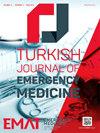Prehospital management of earthquake crush injuries: A collective review
IF 2.3
Q3 EMERGENCY MEDICINE
引用次数: 0
Abstract
Earthquakes are natural disasters which can destroy the rural and urban infrastructure causing a high toll of injuries and death without advanced notice. We aim to review the prehospital medical management of earthquake crush injuries in the field. PubMed was searched using general terms including rhabdomyolysis, crush injury, and earthquake in English language without time restriction. Selected articles were critically evaluated by three experts in disaster medicine, emergency medicine, and critical care. The medical response to earthquakes includes: (1) search and rescue; (2) triage and initial stabilization; (3) definitive care; and (4) evacuation. Long-term, continuous pressure on muscles causes crush injury. Ischemia–reperfusion injury following the relieving of muscle compression may cause metabolic changes and rhabdomyolysis depending on the time of extrication. Sodium and water enter the cell causing cell swelling and hypovolemia, while potassium and myoglobin are released into the circulation. This may cause sudden cardiac arrest, acute extremity compartment syndrome, and acute kidney injury. Recognizing these conditions and treating them timely and properly in the field will save many patients. Majority of emergency physicians who have worked in the field of the recent Kahramanmaraş 2023, Turkey, earthquakes, have acknowledged their lack of knowledge and experience in managing earthquake crush injuries. We hope that this collective review will cover the essential knowledge needed for properly managing seriously crushed injured patients in the earthquake field.地震挤压伤的院前处理:综述
本文章由计算机程序翻译,如有差异,请以英文原文为准。
求助全文
约1分钟内获得全文
求助全文
来源期刊

Turkish Journal of Emergency Medicine
EMERGENCY MEDICINE-
CiteScore
1.70
自引率
0.00%
发文量
30
审稿时长
22 weeks
期刊介绍:
The Turkish Journal of Emergency Medicine (Turk J Emerg Med) is an International, peer-reviewed, open-access journal that publishes clinical and experimental trials, case reports, invited reviews, case images, letters to the Editor, and interesting research conducted in all fields of Emergency Medicine. The Journal is the official scientific publication of the Emergency Medicine Association of Turkey (EMAT) and is printed four times a year, in January, April, July and October. The language of the journal is English. The Journal is based on independent and unbiased double-blinded peer-reviewed principles. Only unpublished papers that are not under review for publication elsewhere can be submitted. The authors are responsible for the scientific content of the material to be published. The Turkish Journal of Emergency Medicine reserves the right to request any research materials on which the paper is based. The Editorial Board of the Turkish Journal of Emergency Medicine and the Publisher adheres to the principles of the International Council of Medical Journal Editors, the World Association of Medical Editors, the Council of Science Editors, the Committee on Publication Ethics, the US National Library of Medicine, the US Office of Research Integrity, the European Association of Science Editors, and the International Society of Managing and Technical Editors.
 求助内容:
求助内容: 应助结果提醒方式:
应助结果提醒方式:


